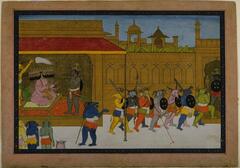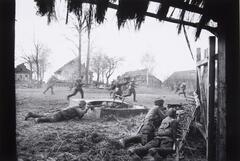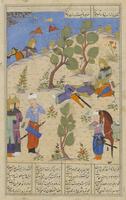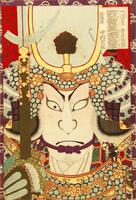Pioneer High School: Power and Conflict Discussion

Râmâyana manuscript, folio 101: Demon Armies Pour Out of Ravana's Castle
ink, opaque watercolor, and gold on paper
9 13/16 in x 13 7/8 in (25 cm x 35.2 cm);9 7/8 in x 13 7/8 in (25.1 cm x 35.2 cm)
Museum Purchase made possible by the Margaret Watson Parker Art Collection Fund
Images
Dimitri Baltermants, Battle for Kamenka Village, Near Moscow, Photograph (2012/2.67)
Shahnama, The Death of Dara, Iranian (1963/1.64)
Râmâyana manuscript, folio 101: Demon Armies Pour Out of Ravana's Castle (2002/1.166)
Rough Wooden Statue of Minister Seishō: Nakamura Shikan IV as the Warrior Satō Kiyomasa (2009/2.21)
Background for Leader: Different Views of Military Conflict
Baltermants: Photograph by a Russian journalistic, documentary photographer, shows soldiers in the pitch of battle during WWII, likely during Nazi Germany’s invasion of Russia in 1941. The capture of Moscow, was seen as vital to the success of this invasion. Hitler believed that once the heart (Moscow) had been cut out of Russia, the whole nation would collapse.
Death of Dara: Manuscript page from Shahnama, or book of Kings, which was a mythological and historical epic valorizing the history of Persia / Iran. This image shows Alexander the Great, a Greek/Macedonian hero, cradling the head of Darius, a Persian emperor, on his deathbed.
Ramayana: Ancient Indian epic. The tale revolves around Rama, a human manifestation of the great Hindu god Vishnu and his antagonist, Ravana, the powerful king of Lanka (modern Sri Lanka). Rama is an emblem of enduring Indian ideals of kingship, duty, and fidelity. Ravana, sometimes shown as the personification of evil, is shown here as regal and noble. Even though he has multiple heads and arms, he is handsome and dignified. In this painting Ravana, in his golden castle, is sending forth his pastel colored demon warriors to repel Rama’s attack.
-
Samurai: there was a celebrity cult surrounding these prints of warriors. People would collect posters of their heroes. They could have been hung in a house or bedroom and were very popular. The many prints work together to give a sense of complexity and flatness. Kabuki actors would vibrate their eyes, and this could be an exaggeration of that movement.
Introduction
Welcome to the object study room. This work rotates, so we can change it. We chose these works to fit your themes today.
Why did we choose these? Quick compare / contrast. Do you see anything in common? Is there anything that connects them? (Form - color, line, media) or (Subject - gender, topic, location)? Let’s investigate them and see if we can come up with some thread.
Close Looking
Perspective: where are you standing? Viewing? In the Baltermants, where is the photographer located? Where are you in relation to this large face (samurai)?
Subject: Who could that person be, and why might he be staring at you? What’s up with his eye? Look closely at the Demon Armies print. Are these “normal” people? What do you notice? Who is the central focus?
Technique: How were these made? What is the medium? In the past, who had access to expensive pigments, who could pay an artist to spend days working on one small print? Notice the brushstrokes.
Power
In our world, how do we indicate power? Clothing, how we walk, technology, cars, money? In a classroom, how do you know who really has control?
Who is in control here? Who holds the power? Provide evidence from each work. Find at least ONE symbol of power in each work (gun, crown, clothing, suit and tie).
Baltermants - is the photographer aligned with power?
Shahnama - how do you know who is rich? Winning the battle? How is the defeated person depicted? What does that say about the qualities of the winner?
Ramayana - Who does not have power?
Japanese warrior: Why do we believe that this guy is fierce?
Drawing Connections and Conclusions:
All include people of power, mainly male, and include references to conflict. What can we observe about the artists, or the culture’s, values and thoughts about people in power, based on their artistic choices?
Relate to literature: Which characters have power in the books you have read? What are their symbols of power? How does the author convey that to you? How to others react to them / how do they treat those who are powerless or inferior? Is that individual or culturally bound? Is the person in power empathetic?
Created For
K-12 EducatorK-12 Student
Museum Visitor
UMMA Docent
UMMA Staff
University Faculty
University Student
Rate this Resource
AVG: 0 | Ratings: 0
& Author Notes
Creative Commons by-nc-saLast Updated
January 29, 2018 7:14 a.m.Report
Reporting Policy



